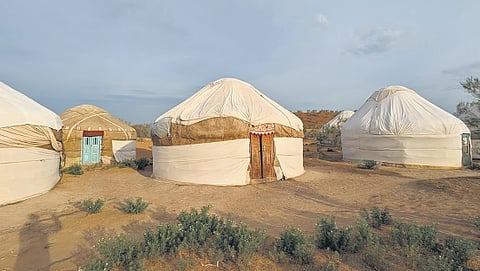
- LIFESTYLE
- FASHION
- FOOD
- ENTERTAINMENT
- EVENTS
- CULTURE
- VIDEOS
- WEB STORIES
- GALLERIES
- GADGETS
- CAR & BIKE
- SOCIETY
- TRAVEL
- NORTH EAST
- INDULGE CONNECT

In his rendition of the star-crossed saga of Layla and Majnu, the renowned 15th-century Sufi poet and Uzbek statesman—Alisher Navoi—casts the desert as a merciless crucible of struggle and exile. If one ventures beyond the regal structures of Samarkand towards the province of Navoi in Uzbekistan, the sheer expanse of the desolate desert lays bare its unforgiving nature. Travelling across the parched Kyzylkum wilderness, one can’t help but ponder how life in the deserts here would have inspired the verses of its eponymous poet.
For centuries, life indeed thrived even in these ‘red sands’ (or kyzylkum in Turkic languages). Across Central Asia, wandering shepherds and tribal clans sheltered themselves in mushroom-shaped yurts fashioned from camel hide. These circular tents, easily dismantled and carted by horses or camels, were constructed from naturally available materials—wooden poles and thick felt rolled from fleece—serving as the perfect portable haven for nomadic life. Today, these yurt camps offer a glimpse into the ways of the past for tourists seeking a taste of antiquity, albeit supplemented with modern amenities.
Inside the yurts, it’s a riot of colours. Vibrant handcrafted carpets and shirdaks (stitched and often colourful felt textiles) adorn the floors and walls, complemented by plush pillows and mattresses, with a characteristic whiff of camel musk. Yet fear not, for human noses acclimate swiftly, and this natural scent doubles as a deterrent to nocturnal pests. Expect shared accommodation that is tidy, comfortable, and dimly lit; alongside open-air sit-outs, sanitation facilities with running water, and snug blankets to ward off the desert chill.
Yurt camps in Navoi are dotted around the Aydarkul—a colossal man-made reservoir created in 1969. This kul (lake) is part of the Nuratau-Kyzylkum Biosphere Reserve, forming the habitat for many endangered bird species and animals, notably the Bukhara deer in the mountain areas. Beyond birdwatching, the lake’s sandy shores call for invigorating swims, relaxed angling and tranquil boat rides. Low cliffs offer vantage points to soak in sweeping panoramas of turquoise waters set against ochre sands—a scene so far from human habitation that it's an invitation for contemplative solitude.
Back at the camp, a leisurely camel safari awaits. At a giant communal yurt made specifically for guests to feast together, sumptuous meals are served. Gastronomy enthusiasts can choose from authentic Uzbek specialities such as plov, manty and shashlik (the Uzbek versions of pulao, dumplings and kebabs respectively), complemented by abundant fruit platters. Seated on the warm carpeted floors, sipping on free-flowing wine, the mood is set for an evening campfire. The night comes alive with the melodies of local musicians by the crackling bonfire. As the fire dies out, a celestial spectacle unfolds above. Devoid of any light pollution, the ink-black desert sky accentuates the wondrous Milky Way.
Rising early at sunrise is recommended to visit the nearby attractions. The capital city of Navoi stands proud as the youngest Uzbek city. There are the remnants of the walls and gate of the Rabati Malik Caravanserai that served as a vital stopover for Central Asian traders of yore along the Silk Route. This surviving masterpiece of Iranian architecture from the 11th-century Karakhanid era served as a royal summer place and a fort as well.
An hour away, the small town of Nurata is said to have originated around the hilltop fortress Nur, which was built by Alexander the Great in the 4th-century BCE. Although now in ruins, its strategic location and complex water system invite wonder. Archaeological discoveries at the Chasma spring right beneath the fortress and the Zukarnay Petroglyphs a few kilometres away, date Nurata’s history to prehistoric periods. Legend has it that millennia ago, a fire rock—perhaps a meteorite—fell from the sky to create a spring of healing waters, lending the town its name, meaning ‘Ray of Father’ or divine light (nur). Today, the Chasma Complex including the spring, the Juma Mosque, the qubba (domed shrine) and the bathhouse, is visited by thousands of believers annually for religious celebrations.
At the flea market flanking the Chasma, one can bargain over exquisite hand-embroidered textiles crafted in the iconic Nurata Suzani style. Historically, would-be brides would delicately stitch distinctive floral patterns on white canvases as wedding heirlooms symbolising fortune and protection for the newlyweds. Today, a few artisans continue to weave together nature’s motifs into social traditions, much like how the offbeat Navoi region blends untamed wilderness with cultural richness.